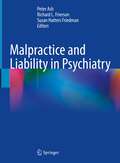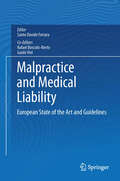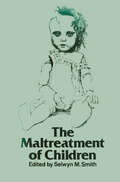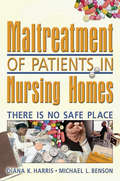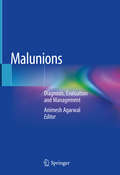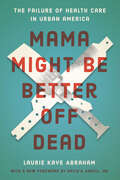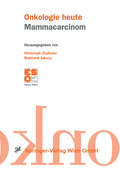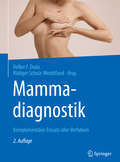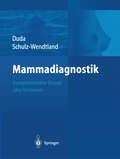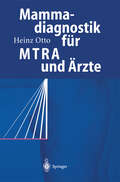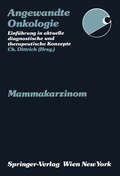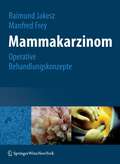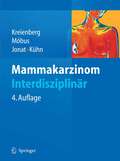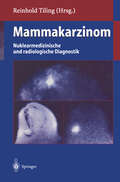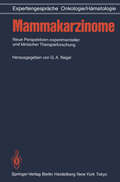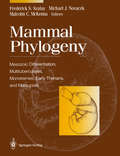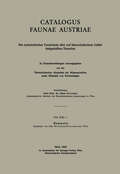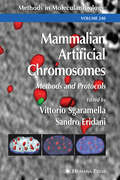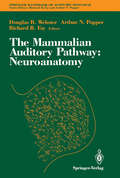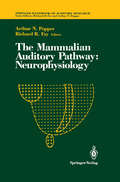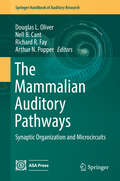- Table View
- List View
Malpractice and Liability in Psychiatry
by Peter Ash Richard L. Frierson Susan Hatters FriedmanThis book comprehensively educates psychiatrists about malpractice and other liability. It is written to also specifically assist psychiatrists who are sued or are involved in other complaints. The first two sections discuss malpractice law and the litigation process; the litigation section mainly addresses some of the more emotionally charged issues, including do’s and don’ts, how an attorney will be looking at the case, the defendant doctor’s testifying at deposition and trial, and the stress of being sued. The subsequent three sections address specific topics that give rise to liability, with each section taking a different perspective such as risks in particular clinical, by practice site, and special issues, including practice in special situations such as the current pandemic. The final section discusses other forms of liability, such as complaints to medical boards or professional association ethics committees. An exceptional work, Malpractice and Liability in Psychiatry, functions as both a go-to handbook and all-encompassing read on the aforementioned topics.
Malpractice and Medical Liability: European State of the Art and Guidelines
by Santo Davide Ferrara, Rafael Boscolo-Berto and Guido VielMedical responsibility lawsuits have become a fact of life in every physician’s medical practice. However, there is evidence that physicians are increasingly practising defensive medicine, ordering more tests than may be necessary and avoiding patients with complicated conditions. The modern practice of medicine is increasingly complicated by factors beyond the traditional realm of patient care, including novel technologies, loss of physician autonomy, and economic pressures. A continuing and significant issue affecting physicians and the healthcare system is malpractice. In the latter half of the 20th century, there was a major change in the attitude of the public towards the medical profession. People were made aware of the huge advances in medical technology, because health problems increasingly tended to attract media interest and wide publicity. Medicine is a victim of its own success in this respect, and people are now led to expect the latest techniques and perfect outcomes on all occasions. This burst of technology and hyper-specialization in many fields of medicine means that each malpractice claim is transformed into a scientific challenge, requiring specific preparation in analysis and judgment of the clinical case in question. The role of legal medicine becomes more and more peculiar in this judicial setting, often giving rise to erroneous interpretations and hasty scientific verdicts, but guidelines on the methodology of ascertainments and criteria of evaluation are lacking all over the world.The aim of this volume is to clarify the steps required for sequential in-depth analysis of events and consequences of medical actions, in order to verify whether, in the presence of damage, errors or non-observance of rules of conduct by health personnel exist, and which causal values and links of their hypothetical misconduct are involved.
The Maltreatment of Children
by Selwyn M. SmithThe maltreatment of children is an issue that has always been with us and civilized societies provide a range of services both social and medical to care for the children and families afflicted. In recent years, greater attention has been drawn to the medical aspects by competent authorities in the fields of forensic medicine, forensic psychiatry, epidemiological psychiatry, child psychiatry and family psychiatry; as well as the social aspects by those child welfare and child care agencies who have the difficult and distasteful task of removing children, with the help of the courts, from parents who can abuse them and are not able to care for them adequately. A multitude of social agencies, whose range of ac tivities involve both the care and, where possible, the social betterment of afflicted families are now involved. Not least in importance is an increase in our global knowledge to help in the prevention or better treatment of these problems. This means more informa tion on familial and genetic factors in human central nervous system develop ment in its broadest sense. This would include how the central nervous system originates, mediates and controls the build up, speed of development and im pulsive release, mastery and direction of aggressive drives and impulses. Very little is so far known about these factors.
Maltreatment of Patients in Nursing Homes: There Is No Safe Place
by Diana Harris Harold G Koenig"Abuse, although often not detected or reported, existed in every facility we surveyed. It is a serious problem."Old, weak, and often cognitively impaired, nursing home patients can be easy targets for physical, psychological, material, and financial mistreatment at the hands of those entrusted with their care, safety, and well-being. Maltreatment of Patients in Nursing Homes: There Is No Safe Place examines the dark side of nursing homes, where not every employee has the commitment of Mother Theresa. This groundbreaking book applies criminological theory to help develop practical methods of controlling abuse and presents the results of the first and only nationwide study on the theft of patients&’ belongings, a form of abuse too often ignored by the nursing home industry. Maltreatment of Patients in Nursing Homes surveys employees, administrators, and family members of patients in 47 nursing homes throughout the United States. Their responses provide invaluable insights on a wide range of topics, including the social and psychological factors that cause different types of abuse, characteristics of nursing home patients and employees, the bureaucracy of nursing homes, victimization rates, workforce issues of nursing home aides, and federal regulations for nursing homes. The information gained from the surveys forms the basis for detailed recommendations for creating a safer environment and reducing all forms of abuse, including theft-prevention training programs, background checks and improved screening of potential employees, education and advocacy for current staff, and the reform of federal regulations.Maltreatment of Patients in Nursing Homes examines: types of physical abuse (restraints, sexual abuse, neglect) the who, what, and why of nursing home theft types of financial abuse (trust accounts, bank accounts, improper charges for services and drugs, identity theft) types of psychological abuse (abandonment, segregation, childlike treatment, verbal abuse) effects of psychological abuse (depression, learned helplessness, psychiatric disorders) reasons for abuse by employees (staff turnover, job burnout, job dissatisfaction, caregiver stress)One of the few books to deal with abuse of the elderly outside a domestic setting, Maltreatment of Patients in Nursing Homes: There Is No Safe Place interprets and analyzes abuse to provide new ways of thinking about this growing problem and new methods of preventing it from growing any more widespread.
Maltreatment of Patients in Nursing Homes: There Is No Safe Place
by Diana Harris Harold G Koenig"Abuse, although often not detected or reported, existed in every facility we surveyed. It is a serious problem."Old, weak, and often cognitively impaired, nursing home patients can be easy targets for physical, psychological, material, and financial mistreatment at the hands of those entrusted with their care, safety, and well-being. Maltreatment of Patients in Nursing Homes: There Is No Safe Place examines the dark side of nursing homes, where not every employee has the commitment of Mother Theresa. This groundbreaking book applies criminological theory to help develop practical methods of controlling abuse and presents the results of the first and only nationwide study on the theft of patients&’ belongings, a form of abuse too often ignored by the nursing home industry. Maltreatment of Patients in Nursing Homes surveys employees, administrators, and family members of patients in 47 nursing homes throughout the United States. Their responses provide invaluable insights on a wide range of topics, including the social and psychological factors that cause different types of abuse, characteristics of nursing home patients and employees, the bureaucracy of nursing homes, victimization rates, workforce issues of nursing home aides, and federal regulations for nursing homes. The information gained from the surveys forms the basis for detailed recommendations for creating a safer environment and reducing all forms of abuse, including theft-prevention training programs, background checks and improved screening of potential employees, education and advocacy for current staff, and the reform of federal regulations.Maltreatment of Patients in Nursing Homes examines: types of physical abuse (restraints, sexual abuse, neglect) the who, what, and why of nursing home theft types of financial abuse (trust accounts, bank accounts, improper charges for services and drugs, identity theft) types of psychological abuse (abandonment, segregation, childlike treatment, verbal abuse) effects of psychological abuse (depression, learned helplessness, psychiatric disorders) reasons for abuse by employees (staff turnover, job burnout, job dissatisfaction, caregiver stress)One of the few books to deal with abuse of the elderly outside a domestic setting, Maltreatment of Patients in Nursing Homes: There Is No Safe Place interprets and analyzes abuse to provide new ways of thinking about this growing problem and new methods of preventing it from growing any more widespread.
Malunions: Diagnosis, Evaluation and Management
by Animesh AgarwalProviding a comprehensive presentation of the diagnosis, evaluation and management of malunions, this generously illustrated text details the current principles, surgical techniques and approaches with these challenging clinical situations. Since each malunion can be fairly specific, the treatment regimens provide guidelines to effectively approach such problems. Opening with a brief overview of the principles of malunions, the remainder of the book is divided by anatomical area and provides evidence-based recommendations, case examples, and preferred treatment/algorithms for both the upper and lower extremities, including the clavicle, proximal and distal humerus, hand and wrist, proximal and distal femur, and tibia and ankle, as well as the pelvis and acetabulum. Specialized circumstances are also discussed, including periprosthetics and joint replacement.Although not every single treatment option is described for every single anatomical area and type of injury, Malunions is an excellent resource for orthopedic trauma surgeons, residents and students, not only for managing these common yet complex problems but also in preventing malunions from occurring by avoiding surgical causes and mitigating patient risk factors.
Mama Might Be Better Off Dead: The Failure of Health Care in Urban America
by Laurie Kaye AbrahamNorth Lawndale, a neighborhood that lies in the shadows of Chicago’s Loop, is surrounded by some of the city’s finest medical facilities, Yet, it is one of the sickest, most medically underserved communities in the country. Mama Might Be Better Off Dead immerses readers in the lives of four generations of a poor, African-American family in the neighborhood, who are beset with the devastating illnesses that are all too common in America’s inner-cities. Headed by Jackie Banes, who oversees the care of a diabetic grandmother, a husband on kidney dialysis, an ailing father, and three children, the Banes family contends with countless medical crises. From visits to emergency rooms and dialysis units, to trials with home care, to struggles for Medicaid eligibility, Laurie Kaye Abraham chronicles their access—or more often, lack thereof—to medical care. Told sympathetically but without sentimentality, their story reveals an inadequate health care system that is further undermined by the direct and indirect effects of poverty. Both disturbing and illuminating, Mama Might Be Better Off Dead is an unsettling, profound look at the human face of health care in America. Published to great acclaim in 1993, the book in this new edition includes an incisive foreword by David Ansell, a physician who worked at Mt. Sinai Hospital, where much of the Banes family’s narrative unfolds.
Mama Might Be Better Off Dead: The Failure of Health Care in Urban America
by Laurie Kaye AbrahamNorth Lawndale, a neighborhood that lies in the shadows of Chicago’s Loop, is surrounded by some of the city’s finest medical facilities, Yet, it is one of the sickest, most medically underserved communities in the country. Mama Might Be Better Off Dead immerses readers in the lives of four generations of a poor, African-American family in the neighborhood, who are beset with the devastating illnesses that are all too common in America’s inner-cities. Headed by Jackie Banes, who oversees the care of a diabetic grandmother, a husband on kidney dialysis, an ailing father, and three children, the Banes family contends with countless medical crises. From visits to emergency rooms and dialysis units, to trials with home care, to struggles for Medicaid eligibility, Laurie Kaye Abraham chronicles their access—or more often, lack thereof—to medical care. Told sympathetically but without sentimentality, their story reveals an inadequate health care system that is further undermined by the direct and indirect effects of poverty. Both disturbing and illuminating, Mama Might Be Better Off Dead is an unsettling, profound look at the human face of health care in America. Published to great acclaim in 1993, the book in this new edition includes an incisive foreword by David Ansell, a physician who worked at Mt. Sinai Hospital, where much of the Banes family’s narrative unfolds.
Mama Might Be Better Off Dead: The Failure of Health Care in Urban America
by Laurie Kaye AbrahamNorth Lawndale, a neighborhood that lies in the shadows of Chicago’s Loop, is surrounded by some of the city’s finest medical facilities, Yet, it is one of the sickest, most medically underserved communities in the country. Mama Might Be Better Off Dead immerses readers in the lives of four generations of a poor, African-American family in the neighborhood, who are beset with the devastating illnesses that are all too common in America’s inner-cities. Headed by Jackie Banes, who oversees the care of a diabetic grandmother, a husband on kidney dialysis, an ailing father, and three children, the Banes family contends with countless medical crises. From visits to emergency rooms and dialysis units, to trials with home care, to struggles for Medicaid eligibility, Laurie Kaye Abraham chronicles their access—or more often, lack thereof—to medical care. Told sympathetically but without sentimentality, their story reveals an inadequate health care system that is further undermined by the direct and indirect effects of poverty. Both disturbing and illuminating, Mama Might Be Better Off Dead is an unsettling, profound look at the human face of health care in America. Published to great acclaim in 1993, the book in this new edition includes an incisive foreword by David Ansell, a physician who worked at Mt. Sinai Hospital, where much of the Banes family’s narrative unfolds.
Mama Might Be Better Off Dead: The Failure of Health Care in Urban America
by Laurie Kaye AbrahamNorth Lawndale, a neighborhood that lies in the shadows of Chicago’s Loop, is surrounded by some of the city’s finest medical facilities, Yet, it is one of the sickest, most medically underserved communities in the country. Mama Might Be Better Off Dead immerses readers in the lives of four generations of a poor, African-American family in the neighborhood, who are beset with the devastating illnesses that are all too common in America’s inner-cities. Headed by Jackie Banes, who oversees the care of a diabetic grandmother, a husband on kidney dialysis, an ailing father, and three children, the Banes family contends with countless medical crises. From visits to emergency rooms and dialysis units, to trials with home care, to struggles for Medicaid eligibility, Laurie Kaye Abraham chronicles their access—or more often, lack thereof—to medical care. Told sympathetically but without sentimentality, their story reveals an inadequate health care system that is further undermined by the direct and indirect effects of poverty. Both disturbing and illuminating, Mama Might Be Better Off Dead is an unsettling, profound look at the human face of health care in America. Published to great acclaim in 1993, the book in this new edition includes an incisive foreword by David Ansell, a physician who worked at Mt. Sinai Hospital, where much of the Banes family’s narrative unfolds.
Mammacarcinom (Onkologie heute)
by Christoph Zielinski Raimund JakeszNeu: Knapp gefaßter Therapie-Leitfaden mit den modernsten Forschungsergebnissen
Mammadiagnostik: Komplementärer Einsatz aller Verfahren
by Volker F. Duda Rüdiger Schulz-WendtlandWie komme ich schnell und zuverlässig zu einer sicheren Diagnose? Der Leitfaden liefert Ihnen interdisziplinäre Antworten rund um eine qualitätsgesicherte Mammadiagnostik. - Bewertung aller wichtigen Verfahren - Klar strukturierte Anleitungen als Befundtrainer - Zahlreiche differentialdiagnostische Bilder zum Vergleich - Anhand von 50 Fallbeispielen sicher zur Diagnose
Mammadiagnostik: Komplementärer Einsatz aller Verfahren
by Volker Duda Rüdiger Schulz-WendtlandWie komme ich schnell und zuverlässig zu einer sicheren Diagnose? Der Leitfaden liefert Ihnen interdisziplinäre Antworten rund um eine qualitätsgesicherte Mammadiagnostik. - Bewertung aller wichtigen Verfahren - Klar strukturierte Anleitungen als Befundtrainer - Zahlreiche differentialdiagnostische Bilder zum Vergleich - Anhand von 50 Fallbeispielen sicher zur Diagnose
Mammadiagnostik für MTRA und Ärzte
by Heinz OttoMammadiagnostik auf hohem Niveau - für eine optimale Abklärung und Frühdiagnostik von Brustkrebs. - Möglichkeiten, Risiken und Stellenwert bildgebender und interventioneller Verfahren - Die wichtigsten Befunde - Methodik, Qualitätssicherung, Richtlinien
Mammakarzinom (Angewandte Onkologie)
by G. Berlakovich C. Hausmaninger H. Hausmaninger B. Hirn T. Hölzenbein R. Jakesz A. Reiner G. Reiner E. Salomonowitz W. Seitz B. Teleky C. ZielinskiIm dritten Band der Buchreihe Angewandte Onkologie wird als spezifische Tumorentität das Mammakarzinom behandelt. Aufgabe dieser Buchreihe ist primär die Präsentation von gesichertem Wissen über Epidemiologie, Diagnostik, Therapie, Verlaufsuntersuchungen und Prognoseerstellung bei einzelnen Tumorentitäten, um den onkologisch Tätigen und Interessierten einen Überblick zu geben und eine Entscheidungshilfe für ein optimiertes, ärztliches Vorgehen in Einzelfällen darzustellen. Ärzten, Medizinstudenten und allen, die sich einen raschen Einblick in spezifische onkologische Fragestellungen verschaffen wollen, soll diese Buchreihe praktische Hilfeleistung geben.
Mammakarzinom: Operative Behandlungskonzepte
by Raimund Jakesz Manfred FreyMammakarzinom: die häufigste Krebserkrankung der Frau. Die Autoren geben hier einen Überblick über derzeit gängige interventionelle, resektive und onkoplastische Konzepte. Etablierte Therapien ergänzen sie durch (noch) experimentelle Methoden. So werden sie etablierten Qualitätsstandards als auch neuen Behandlungsstrategien gerecht, denn auch chirurgisches Wissen ist ständig im Fluss. Deshalb thematisieren sie Konzepte, die über das evidenzbasiert Bewährte hinausgehen. Dieses Kompendium modernster operativer Behandlungskonzepte bietet Chirurgen kompetente Hilfe im Umgang mit Brustkrebs-Patientinnen. Plus: 150 meist farbige Abbildungen.
Mammakarzinom: Interdisziplinär
by Walter Jonat Thorsten Kühn Rolf Kreienberg Volker MöbusHilfreiches Buch für jeden Arzt der Patientinnen mit Mammakarzinom behandelt. Spezialisten aller Fachdisziplinen besprechen umfassend alle Aspekte des Krankheitsbildes. Ärzte aus Klink und Praxis finden aktuelles Wissen von Epidemiologie und Molekularbiologie, über Diagnostik und Therapie bis hin zu Nachsorge und Rehabilitation. Praxisnah werden diagnostisches Vorgehen, operative und Strahlentherapie, adjuvante sowie Hormontherapie dargestellt. Ebenso sind Informationen zu wichtigen Medikamenten, plastischer Chirurgie, Schmerzbehandlung, Selbsthilfegruppen und zu psychosozialen Aspekten enthalten.
Mammakarzinom: Nuklearmedizinische und radiologische Diagnostik
by J. Lissner Reinhold Tiling K. HahnDer aktuelle State-of-the-art, klinik- und praxisorientiert mit umfangreichem Bildmaterial für Sie zusammengestellt!Mit diesem Buch erhalten Sie erstmals einen umfassenden Überblick über etablierte und neuartige radiologische Diagnoseverfahren, unmittelbar an Ihren klinischen Fragestellungen orientiert:-> alle Verfahren der bildgebenden Diagnostik und Differentialdiagnostik des Mammakarzinoms und dessen Metastasen-> etablierte Verfahren, moderne Schnittbilddiagnostik,-> neue nuklearmedizinische Methoden wie Szintigraphie und Positronenemissionstomographie und deren erste klinische Ergebnisse-> Möglichkeiten und Grenzen der jeweiligen Verfahren mit kritischer Beurteilung ihrer klinischen Wertigkeit.Der AutorReinhold Tiling ist Facharzt für Radiologische Diagnostik und Nuklearmedizin und als Oberarzt an der Klinik und Poliklinik für Nuklearmedizin der Ludwig-Maximilians-Universität, München tätig. Er wurde 1995 mit dem Hans-Creutzig-Preis der Rheinisch-Westfälischen Gesellschaft für Nuklearmedizin ausgezeichnet.
Mammal Phylogeny: Mesozoic Differentiation, Multituberculates, Monotremes, Early Therians, and Marsupials
by Malcolm C. McKenna Michael J. Novacek Frederick S. SzalayThe roots of this book and its sister volume, Mammal Phylogeny: Placentals, go back to discussions and plans, shelved for a while, between F. S. Szalay and W. P. Luckett during the international and multidisciplinary symposium on rodent evolution sponsored by NATO, July 2-6, 1984, in Paris. That conference, orga nized by W. P. Luckett and J. -L. Hartenberger, the proceedings of which were published in 1985, proved an inspiring experience to all of the participants, as this was repeatedly expressed both during and after the meetings. In addition to issues relating to rodents, general theoretical topics pertaining to the evolutionary biol ogy and systematics of other groups of mammals regularly surfaced during the presentations and discussions. M. J. Novacek, who was also a participant in the rodent symposium, shared with Luckett and Szalay the enthusiasm acquired there, and he also expressed strong interest for a meeting on mammal evolution with a general focus similar to that of the rodent gathering. In 1988, Szalay and Luckett, after having planned in detail a program, direc tion, and core list of participants, were awarded a $30,000 grant by the Alfred P. Sloan Foundation through the Research Foundation of the City University of New York. The grant was contingent upon obtaining additional funds sufficient to assure that the symposium would be held. Raising the remaining funds proved to be a problem.
Mammalian Artificial Chromosomes: Methods and Protocols (Methods in Molecular Biology #240)
by Vittorio Sgaramella and Sandro EridaniIn 1996, we organized a workshop, inter alia, at the National Research Co- cil in Milan under the generous sponsorship of the European Science Foun- tion. On that occasion, a small group of investigators convened from many countries and presented early evidence of the possibility of assembling basic units of mammalian chromosomes into artificial constructs (or, indeed, red- ing the relevant components to more manageable dimensions and defined c- stitution). Progress in the following years has been slow but steady. Many scientists who took part in the workshop have since been engaged in active and prod- tive research. It goes to the credit of Humana Press to have realized the need for a book on artificial chromosomes that aims to provide better tools to all scientists committed to this field who are confronted with very difficult tech- cal problems. We have strived to cover in Mammalian Artificial Chromosomes: Methods and Protocols all relevant areas of artificial chromosome research, from basic genetics to daring attempts to build new tools for genetic therapy. We are of course grateful to the authors who have accepted the task of describing the technical steps and pitfalls that can be encountered in their research. Rarely has a very delicate methodology been presented with such meticulous care. We have been helped in this enterprise by the excellent librarian of the LITA Institute in Segrate, Italy, Ms. Claudia Piergigli, whom we thank warmly. Ms.
The Mammalian Auditory Pathway: Neuroanatomy (Springer Handbook of Auditory Research #1)
by Douglas B. Webster Richard R. FayThe Springer Handbook of Auditory Research presents a series of com prehensive and synthetic reviews of the fundamental topics in modem auditory research. It is aimed at all individuals with interests in hearing research including advanced graduate students, postdoctoral researchers, and clinical investigators. The volumes will introduce new investigators to important aspects of hearing science and will help established inves tigators to better understand the fundamental theories and data in fields of hearing that they may not normally follow closely. Each volume is intended to present a particular topic comprehensively, and each chapter will serve as a synthetic overview and guide to the literature. As such, the chapters present neither exhaustive data reviews nor original research that has not yet appeared in peer-reviewed journals. The series focusses on topics that have developed a solid data and con ceptual foundation rather than on those for which a literature is only beginning to develop. New research areas will be covered on a timely basis in the series as they begin to mature.
The Mammalian Auditory Pathway: Neurophysiology (Springer Handbook of Auditory Research #2)
by Richard R. FayThe Springer Handbook of Auditory Research presents a series of com prehensive and synthetic reviews of the fundamental topics in modern auditory research. It is aimed at all individuals with interests in hearing research including advanced graduate students, postdoctoral researchers, and clinical investigators. The volumes will introduce new investigators to important aspects of hearing science and will help established inves tigators to better understand the fundamental theories and data in fields of hearing that they may not normally follow closely. Each volume is intended to present a particular topic comprehensively, and each chapter will serve as a synthetic overview and guide to the literature. As such, the chapters present neither exhaustive data reviews nor original research that has not yet appeared in peer-reviewed journals. The series focusses on topics that have developed a solid data and con ceptual foundation rather than on those for which a literature is only beginning to develop. New research areas will be covered on a timely basis in the series as they begin to mature.
The Mammalian Auditory Pathways: Synaptic Organization and Microcircuits (Springer Handbook of Auditory Research #65)
by Douglas L. Oliver Nell B. Cant Richard R. Fay Arthur N. PopperThe auditory system is a complex neural system composed of many types of neurons connected into networks. One feature that sets the auditory system apart from other sensory systems, such as somatosensory or visual systems, is the many stages of neural processing that occur between the ear in the periphery and the cerebral cortex. Each stage is composed of specialized types of neurons connected in specific microcircuits that perform computations on the information about sound. To understand this processing, all the tools of neuroscience must be employed. The proposed text integrates cell biology, synaptic physiology, and electrophysiology to fully develop the topic, presenting an overview of the functional anatomy of the central auditory system. It is organized based on the neuronal connectivity of the central auditory system, which emphasizes the neurons, their synaptic organization, and their formation of functional pathways and microcircuits. The goal of the book is to stimulate research into the cell biology of the central auditory system and the characteristics of the specific neurons and connections that are necessary for normal hearing. Future research on the development of the central auditory including that employing stem cells will require such information in order to engineer appropriate therapeutic approaches.
